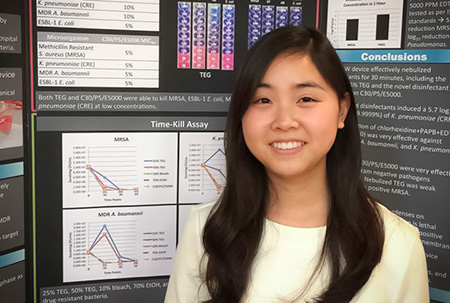
By:
- Heather Buschman
Published Date
By:
- Heather Buschman
Share This:
Middle School Science Project Leads to Better Contact Lens Solution
Janie Kim was in 8th grade at Thurgood Marshall Middle School in Scripps Ranch when she had a good idea for a science fair project—how good are contact lens solutions at killing the bacteria that commonly cause eye infections? Which of the many commercially available solutions are the best?

Janie Kim with her latest science fair presentation
“I had these questions because I wear contacts, I never clean them properly, and I’ve had eye infections myself,” Janie said.
To get started, she Googled “biomedical researchers in San Diego” and came across Dr. Victor Nizet, a professor and infectious disease researcher in the UC San Diego School of Medicine. She decided to email him.
Nizet was impressed and, as a wearer of contact lenses himself, curious. He responded within two minutes, to Janie’s great excitement. “I think I screamed and ran to tell my parents,” she said.
But rather than provide a middle schooler with human pathogens to tinker with at home, Nizet invited Janie to test her ideas in his lab. There, researchers already grow and study eye infection-causing bacteria such as Pseudomonas and methicillin-resistant Staphylococcus aureus.
First, though, they had to wait until Janie turned 14 before she was legally allowed to work in the lab.
“I was amazed at how Janie approached the science, even at such a young age,” Nizet said. “Her questions, independent thinking, and troubleshooting abilities were everything I could hope for in a senior undergraduate or early graduate student.”
Nizet was also surprised to find how little research had been done previously on the antimicrobial properties of contact lens solutions, especially given how many people wear them.
In the end, Janie and M.D./Ph.D. graduate student Leo Lin, Janie’s mentor in the Nizet lab, made an unexpected finding. Not only did they determine which brand-name contact lens solution are the best at killing bacteria, they took things a step further. They looked at the individual ingredients that make up contact lens solution and came up with a unique combination of three that together are approximately five times better at killing bacteria than anything currently on the market. The magic recipe: 30 ppm chlorhexidine, 5 ppm PAPB, and 5000 ppm EDTA.
Janie went on to win first place at the San Diego Science Fair and an honorable mention at the state science fair. The team recently published their results in the journal Antimicrobial Agents and Chemotherapy. Janie, now a junior in high school, and Lin are co-first authors on the paper. That means Janie can add an accomplishment to her college applications that is typically the dream of graduate students a decade older than her.
“It’s been almost four years since I started in the Nizet lab and seeing it all come together into this publication is so rewarding,” Janie said.
If there’s a company willing to follow up on this, Nizet says Janie’s research could help reduce eye infection rates in the millions of contact lens wearers in the world.
Janie will start her college applications this summer. She plans to major in biology at a school where she’ll gain exposure to a wide variety of topics and biomedical applications, and simultaneously pursue her love of creative writing.
In the meantime, Janie is already back at it—taking on new science fair competitors with a prototype device that uses acoustic technology to aerosolize antimicrobial compounds.
Share This:
You May Also Like
Stay in the Know
Keep up with all the latest from UC San Diego. Subscribe to the newsletter today.


